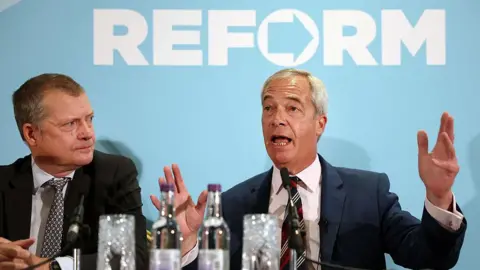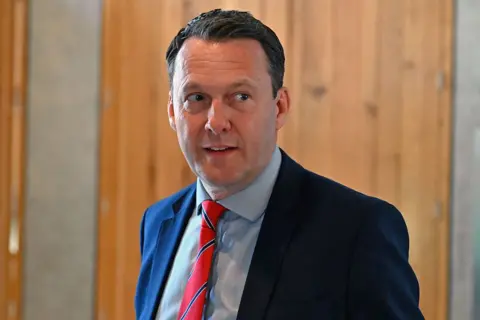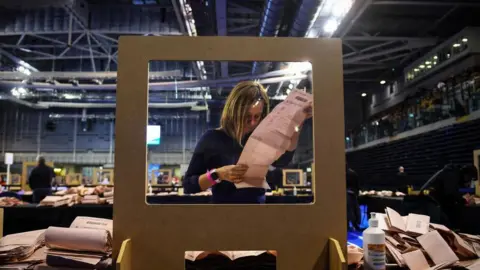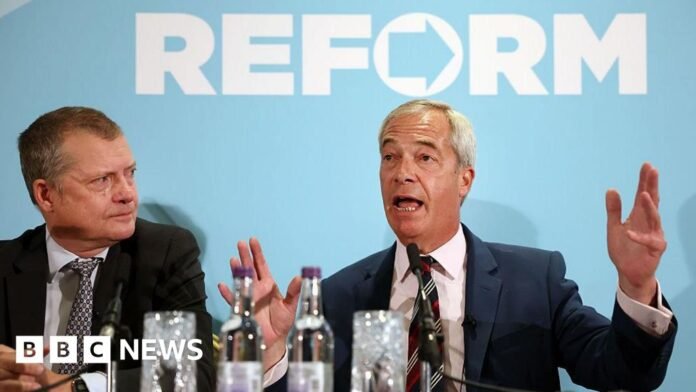BBC Scotland political correspondent
 Getty Images
Getty ImagesWith eight months still to go until the Holyrood election, Reform UK leader Nigel Farage has confidently predicted that the Conservatives will soon cease to be a political force in Scotland.
Farage was speaking as he announced that Graham Simpson had joined Reform after becoming the third MSP to quit the Tories in the past four months.
It leaves Scottish Conservative leader Russell Findlay facing enormous questions about the future of his party, which is now consistently trailing Reform in opinion polls.
With Reform apparently on track to make a major electoral breakthrough next May – something that seemed unthinkable not so long ago – are the Conservatives facing an existential threat in Scotland from their right-wing rivals?
 Getty Images
Getty ImagesReform UK has led the Tories in four of the last five Holyrood polls, on both constituency and list voting intention.
They had a strong third place finish in the Hamilton by-election in June, winning 26% of the vote to the Conservative 6%, and have had a decent showing in a number of council by-elections.
This is part of a wave the party is riding UK-wide, with Nigel Farage’s outfit regularly in the lead in Westminster polls.
Polling guru Prof Sir John Curtice has said the party “poses a significant threat to the Conservatives and Labour’s prospects at Holyrood too”.
More than a dozen Scottish Tory councillors had already moved across to Reform in advance of Simpson.
You can perhaps see why an increasingly embattled Findlay would be tempted to shift his party to the right to combat this threat.
He has already aligned with a number of Reform policies, hitting out at net-zero initiatives and describing protests outside hotels housing asylum seekers as “understandable”.
But such a shift risks alienating the moderate centre-right voter base established under the leadership of Ruth Davidson, which helped the Tories overtake Labour at Holyrood.
When Jamie Greene jumped ship for the Lib Dems in April, he complained that the party was becoming “Trump-esque in style and substance”.
Meanwhile another MSP, Jeremy Balfour, has just opted to go sit as an independent while complaining that the party has lost its small-c conservative identity.
That the three departing MSPs have scattered in different directions underlines the challenge facing Findlay.
It feels a bit like the way Labour was pulled apart in the aftermath of the 2014 independence referendum, losing support at both ends of the spectrum.
And just as the Tories profited from that collapse, Reform are itching to capitalise now.
 Getty Images
Getty ImagesTory sources cheerfully ripped into Simpson’s character in the wake of his defection, saying that “of all our MSPs, they’ve got the worst of the lot”.
But the principle and motivation behind the move might be more worrying to the party than the loss of him personally.
Simpson has clearly calculated that he has a better chance of being re-elected next year wearing a turquoise rosette.
Specifically, he will be hoping to top Reform’s regional list in central Scotland.
This is a part of the country where the party has performed well in council by-elections, with a trio of strong third-place finishes in West Lothian (which is joining the electoral region due to boundary changes).
Conservatives I’ve spoken to are already war-gaming scenarios for next year’s election.
These invariably involve Reform taking seats on the regional lists – which were fertile ground for the Conservatives in 2021, returning 26 of their 31 MSPs.
The approach of targeting the lists was clear from the party’s “peach vote Tory” placards – a nod to the colour of the regional ballot papers – alongside the familiar “stop indyref” in May 2021.
But some members have complained that the party is now too focused on shoring up support in its rural heartlands in the North East and the Borders, to defend its five constituency seats.
Jeremy Balfour was the latest to complain that more urban areas in the central belt were neglected, saying the party has few ideas for cities like Edinburgh and Glasgow.
 Getty Images
Getty ImagesOne piece of comfort for Findlay will be that this has happened before.
Michelle Ballantyne defected to Reform not that long before the 2021 election, but the party (then under the leadership of Richard Tice) only polled 0.2% of the vote, while the Tories kept all of their 31 seats.
Meanwhile in 2016, on the eve of Brexit, Farage’s previous vehicle, UKIP, only managed 2% of the vote at Holyrood while the Conservatives climbed to second place.
The wider political picture looks markedly different this time round though, and most pollsters agree that the 2025 version of Reform is no paper tiger.
The Tories have just been on the wrong end of a Labour landslide at Westminster, and as former leader Jackson Carlaw put it last week, it takes a while before people start to listen to you again after that kind of reversal.
A generally scunnered feeling persists among voters, and Reform has capitalised on that with its anti-establishment narrative.
And in previous elections, the Tories were able to campaign essentially on a single issue – their opposition to another independence referendum.
It is not at all clear that the constitution will define next year’s contest, for all that John Swinney says he is targeting an SNP majority to deliver indyref2.
Findlay is trying to craft a platform around the idea of “common sense” policies, but he needs to clearly define what his party is offering.
Reform will need to do the same thing, and having to defend specific manifesto policies rather than the vibes-based approach they currently take may make life more difficult for Farage.
But what is already clear is that there is going to be a huge range of options for voters next May, precipitating an almighty struggle for their support.
 Getty Images
Getty ImagesThere are now seven parties represented at Holyrood, and Reform entering the fray is very much not just a problem for the Tories.
Not only is the party picking up votes in places where the Conservatives have never been strong performers, the race for seats is a zero-sum game.
Holyrood’s system of proportional representation does make it easier for smaller parties to return MSPs.
But there are still only so many to go around – seven seats on each of the eight regional lists.
If Reform start picking off some of them – and on current polling they should – it would see other parties nudged out as a result.
The odd seat in Glasgow and Edinburgh aside, the Greens tend to put all of their eggs in the regional list basket.
Some analysis has suggested that they could have the most to lose from a Reform surge, in terms of being able to secure more than one seat per region.
If the regional vote is splintered between a lot of parties, it could also raise the bar in terms of others making the grade at all.
Alba is pinning its hopes of ever making an electoral breakthrough on the regional vote, while talk continues of Jeremy Corbyn setting up a new party on the left.
With a record number of MSPs choosing to step down, Holyrood is guaranteed to look very different after the election.
These shifts in party allegiance suggest the make-up of the parliament could be much changed too.
Source link 2025-08-28 10:54:00 www.bbc.com https://www.bbc.com/news/articles/cly3523qrl8o?at_medium=RSS&at_campaign=rss



